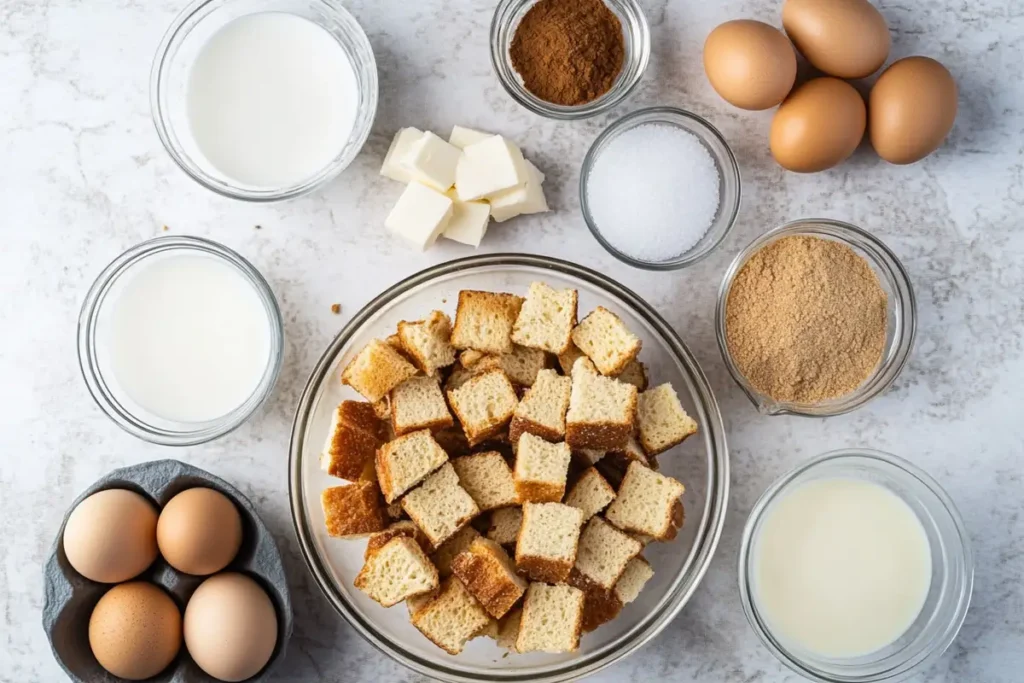Whether hosting a cozy weekend brunch or preparing a memorable holiday breakfast, sourdough French toast casserole is the ultimate comfort dish. It’s a breeze, combining sourdough bread’s tangy complexity and traditional French toast’s creamy sweetness. This casserole, with its easy preparation, crowd-pleasing nature, and endless customization options, will quickly become a household favorite.
Let’s dive into the secrets of crafting this scrumptious recipe and explore variations, serving ideas, and expert tips to make it just right for every occasion!
Table of Contents
Introduction and Overview
Introduction to Sourdough French Toast Casserole
Oh, the joy of a well-made sourdough French toast casserole! It’s more than just a dish; it’s a warm hug for your taste buds. Imagine golden chunks of sourdough bathed in a rich custard, baked to perfection, and topped with your favorite flavors—sweet or savory. The best part? It’s as effortless as it is indulgent.
But why sourdough, you ask? Its tangy profile and sturdy texture make it the ideal bread for absorbing custard without turning soggy. Plus, sourdough is a healthier choice than many other breads, thanks to its natural fermentation process, making you feel good about what you’re serving.
What Makes It Special
This casserole isn’t your average breakfast bake. It’s an ingenious twist on French toast that saves time, minimizes effort, and maximizes flavor. Unlike traditional French toast, cooked slice by slice, the casserole is baked in a single dish. It saves you from standing over a hot stove and creates a delightful contrast between the soft, custard-like interior and the crisp, golden crust.
Moreover, the dish’s adaptability is a canvas for your creativity, suiting almost any occasion—from casual Sunday mornings to elaborate holiday feasts. Sprinkle in your creativity, and you’ll discover endless ways to make it your own!
Understanding Sourdough French Toast Casserole
What Is Sourdough French Toast Casserole?
At its heart, sourdough French toast casserole is a baked rendition of classic French toast, where sourdough bread serves as the star. Instead of dipping and frying individual slices, this dish layers cubed bread with a creamy custard mixture and bakes until golden and bubbling. The result? A luscious, slightly tangy casserole that strikes the perfect balance between soft and crispy textures.
What makes it truly shine is its versatility. Want a sweet treat? Load it with cinnamon, vanilla, and maple syrup. Prefer savory? Add herbs, cheese, or even bits of bacon. This dish transforms easily to fit your cravings, making it a hit at any gathering.
Why Sourdough Bread?
Not all bread is created equal when it comes to this casserole. Sourdough stands out for several reasons:
- Texture: Its hearty structure ensures the bread doesn’t become mushy when soaked in custard.
- Flavor: The natural tanginess of sourdough adds depth, cutting through the sweetness or complementing savory flavors.
- Health Benefits: Rich in probiotics and easier to digest, sourdough is a gut-friendly alternative to standard bread.
Using sourdough also brings a rustic charm to the dish, reminding us of artisanal bread-making traditions that elevate any recipe.
Occasions for Serving
Sourdough French toast casserole fits seamlessly into numerous occasions:
- Brunch Gatherings: Ideal for feeding a crowd without constant kitchen duty.
- Holiday Breakfasts: A festive, warming dish that can be prepared beforehand.
- Family Dinners: Perfect for those breakfast-for-dinner nights when comfort food calls.
Whenever you serve it, this casserole delivers a hearty, memorable meal that leaves everyone asking for seconds.
Ingredients and Preparations
Essential Ingredients

Creating a sourdough French toast casserole requires a few staple ingredients, most of which are likely already in your pantry or fridge:
- Sourdough Bread: Look for slightly stale bread for better custard absorption.
- Eggs: The backbone of the custard, lending richness and structure.
- Milk and Cream: A mix of both creates a creamy, velvety texture.
- Vanilla and Cinnamon: For that signature French toast flavor.
- Sweetener: Maple syrup, brown sugar, or honey enhances the sweetness.
Optional Add-ins
One of the joys of this casserole is its ability to adapt. Here are some ingredients to elevate your dish:
- Fruits: Blueberries, sliced bananas, or diced apples for natural sweetness and color.
- Nuts: Toasted pecans or almonds add crunch and depth.
- Spices: Nutmeg, cardamom, or ginger for a unique twist.
- Savory Options: Cheese, caramelized onions, or diced ham for a savory casserole.
Preparing the Ingredients
Getting everything ready ensures a smooth cooking process:
- Bread Prep: Cube the sourdough into bite-sized pieces. If the bread isn’t stale, lightly toast it to reduce moisture.
- Custard Mix: Whisk together eggs, milk, cream, vanilla, cinnamon, and sweetener until fully combined.
- Toppings: Chop fruits, toast nuts, or shred cheese as needed.
Having everything prepped and organized allows you to easily layer and bake the casserole, making it a stress-free process from start to finish.
Step-by-Step Cooking Instructions
Prepping the Baking Dish
Before diving into assembly, preparing your baking dish properly is essential. It not only ensures a flawless bake but also minimizes cleanup later.
- Grease the Dish: Use butter or cooking spray to coat your dish thoroughly, preventing the casserole from sticking.
- Layer the Bread: Arrange the cubed sourdough bread evenly in the dish. For extra flair, alternate layers with add-ins like fruit or nuts.
Baking The Sourdough French toast casserole
Follow these steps to achieve the perfect sourdough French toast casserole:

- Soaking the Bread: Slowly pour the custard mixture over the bread, ensuring each piece is well-saturated. Gently press down to help the bread absorb the liquid.
- Chill Time (Optional): Cover the dish and let it sit in the refrigerator for 30 minutes overnight for maximum flavor and texture.
- Preheating the Oven: Set your oven to 350°F (175°C) and let it preheat fully.
- Bake: Remove the casserole from the fridge (if chilled), cover it with foil, and bake for 30 minutes. Then, remove the foil and bake for 15–20 minutes to achieve a golden, crisp top.
Finishing Touches
Once baked, let the casserole cool for about 5 minutes before serving. This brief rest time helps the custard set and makes slicing easier. For an added touch, sprinkle powdered sugar or drizzle maple syrup over the top before digging in!
Variations and Customizations
Flavor Variations

The beauty of sourdough French toast casserole lies in its adaptability. Here are a few delicious twists:
- Sweet and Fruity: Add fresh berries, diced apples, or pineapple chunks. A sprinkle of brown sugar caramelizes beautifully during baking.
- Chocolate Lovers’ Delight: Incorporate chocolate chips or a cocoa-infused custard for a dessert-worthy version.
- Savory Spin: Mix in grated cheese, chopped herbs, or cooked bacon for a delicious breakfast bake.
Dietary Adaptations
Making this dish inclusive for different dietary needs is simpler than you’d think:
- Gluten-Free: Substitute with gluten-free sourdough or another suitable bread.
- Dairy-Free: Use almond milk, coconut milk, or oat cream instead of dairy.
- Vegan Option: Swap eggs for flaxseed or chia seed “eggs” and use plant-based milk.
Cultural Twists
Experimenting with regional flavors can take your casserole to a whole new level:
- Middle Eastern Flair: Add cardamom and saffron to the custard and garnish with pistachios.
- Tropical Touch: Infuse coconut milk and top with toasted coconut flakes.
- European Elegance: Incorporate a layer of Nutella or jam for a decadent continental vibe.
Tips for Perfect Sourdough French Toast Casserole
Choosing the Right Bread
Not all sourdough is created equal, and picking the right loaf is crucial for success:
- Stale or Day-Old Bread: Slightly stale sourdough absorbs custard better than fresh bread, ensuring a moist yet firm texture. If your bread is too fresh, lightly toast it to dry it out.
- Thick Slices: Opt for hearty slices or cubes that hold up during soaking and baking without disintegrating.
Custard Consistency
The custard is the heart of a perfect casserole. To nail it every time:
- Use Whole Ingredients: Full-fat milk and cream create a luxurious, creamy texture.
- Whisk Thoroughly: Blend the eggs, milk, and other ingredients until smooth to avoid streaks or uneven cooking.
- Ratio Matters: Stick to a balanced liquid-to-bread ratio; too much custard makes the dish soggy, while too little leaves it dry.
Baking Secrets
The right baking technique ensures that your casserole emerges from the oven with a soft center and golden crust:
- Preheat Properly: A fully preheated oven guarantees even cooking.
- Cover and Uncover: Start with the dish covered to trap moisture, then uncover it to allow the top to crisp.
- Test for Doneness: Insert a knife into the center. If it comes out clean, your casserole is ready!
Following these tips, your sourdough French toast casserole will always be perfect.
Serving Sourdough French Toast Casserole
Pairing with Drinks
Pairing the casserole with the right beverage elevates the meal experience:
- Classic Choices: A hot cup of coffee or tea complements the richness of the casserole.
- Brunch Favorites: Serve with mimosas, fresh orange juice, or a frothy cappuccino for a festive touch.
- Comforting Warmth: Try hot chocolate or chai latte for a cozy pairing.
Best Toppings

The right toppings transform this dish into a visual and culinary masterpiece:
- Fresh Fruits: Sliced strawberries, blueberries, or caramelized bananas.
- Sweet Additions: Dust with powdered sugar or drizzle with maple syrup, honey, or caramel sauce.
- Crunchy Extras: Sprinkle toasted nuts or granola for added texture.
Side Dishes
For a balanced meal, consider serving the casserole with:
- Savory Sides: Crispy bacon, sausage links, or smoked salmon.
- Light Options: A fresh green salad with a citrus vinaigrette adds a refreshing contrast.
- Festive Sides: Roasted potatoes or a fruit salad for a brunch feast.
Nutrition Information and Dietary Modifications
Nutritional Breakdown
Enjoying sourdough French toast casserole doesn’t have to mean straying far from your nutritional goals. Here’s a general breakdown of its contents:
- Calories: A typical serving ranges between 250–400 calories, depending on the ingredients and toppings.
- Protein: Eggs and milk provide about 8–12 grams per serving.
- Carbs: Expect 30–40 grams from the sourdough bread and sweeteners.
- Fats: Around 10–20 grams, primarily from eggs, milk, and cream.
This dish provides a balanced mix of macronutrients, but the values vary based on customizations.
Healthy Modifications
Small tweaks can make this dish fit various dietary preferences while retaining its flavor:
- Lower-Calorie Options
- Use skim milk or almond milk instead of cream.
- Sweeten with stevia, monk fruit, or just a drizzle of maple syrup.
- High-Protein Boost
- Add a scoop of vanilla protein powder to the custard.
- Include Greek yogurt as a topping for extra protein and creaminess.
- Heart-Healthy Choices
- Swap butter for olive oil or coconut oil when greasing the dish.
- Include walnuts or chia seeds for a boost of omega-3s.
These modifications ensure the casserole remains delicious while aligning with your health goals!
Common Questions Answered (FAQs)
What drink goes well with French toast?
French toast pairs wonderfully with beverages like freshly brewed coffee, lattes, or a classic mimosa for brunch. Consider a glass of cold milk or fresh orange juice for a refreshing twist if you prefer non-caffeinated options.
What goes well with French toast?
Sweet options like fresh fruits, whipped cream, or a dusting of powdered sugar enhance the dish’s flavor. If you want savory, pair it with crispy bacon, sausage, or a dollop of crème fraîche for contrast.
What is the secret to good sourdough bread?
The magic lies in the fermentation process, which gives sourdough its signature tang and chewy texture. Opt for bread with a well-developed crust and airy interior. Using day-old bread makes it even better for absorbing the custard in this recipe.
What is French toast good with?
French toast works beautifully as a main dish alongside complementary foods like scrambled eggs, fresh fruit salad, or smoked salmon. Its versatility allows it to fit into breakfast, brunch, or dessert menus.
How do you store and reheat leftovers?
To store leftovers, wrap the casserole tightly or place it in an airtight container. Refrigerate for up to 3 days or freeze for up to a month. Reheat in the oven at 300°F (150°C) for 10–15 minutes to restore its texture and warmth.
Can you make sourdough French toast casserole ahead of time?
Absolutely! Prepare the casserole the night before, cover it, and refrigerate overnight. Bake it as directed for a stress-free meal in the morning, perfect for hosting or busy mornings.

